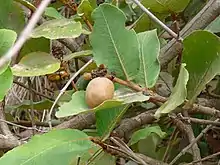Neocarya
Neocarya is a genus of plant in family Chrysobalanaceae described as a genus in 1976.[1][3]
| Neocarya | |
|---|---|
 | |
| Scientific classification | |
| Kingdom: | Plantae |
| Clade: | Tracheophytes |
| Clade: | Angiosperms |
| Clade: | Eudicots |
| Clade: | Rosids |
| Order: | Malpighiales |
| Family: | Chrysobalanaceae |
| Genus: | Neocarya (DC.) Prance ex F.White |
| Species: | N. macrophylla |
| Binomial name | |
| Neocarya macrophylla (Sabine) Prance ex F.White | |
| Synonyms[1][2] | |
| |
It contains only one known species, Neocarya macrophylla, native to western and central Africa from Senegal to the Nigeria, and also in South Sudan. It is commonly known in English as the Gingerbread Plum, despite not being related to the true Plum (Prunus sp.).[2]
References
- Tropicos, Neocarya (DC.) Prance ex F. White
- Kew World Checklist of Selected Plant Families
- White, Frank. 1976. Bulletin du Jardin Botanique National de Belgique 46(3–4): 308
External links
- Dressler, S.; Schmidt, M. & Zizka, G. (2014). "Neocarya". African plants – a Photo Guide. Frankfurt/Main: Forschungsinstitut Senckenberg.
This article is issued from Wikipedia. The text is licensed under Creative Commons - Attribution - Sharealike. Additional terms may apply for the media files.